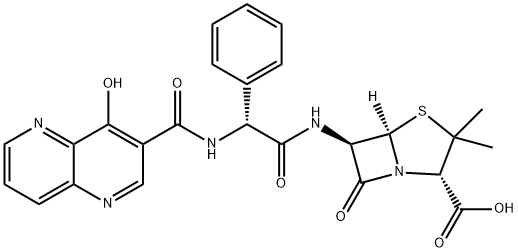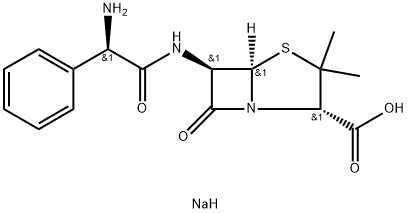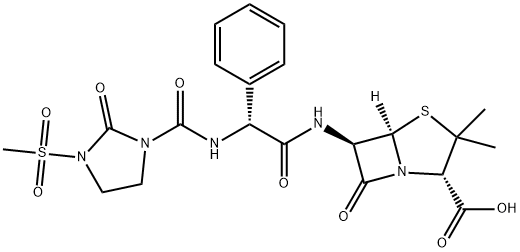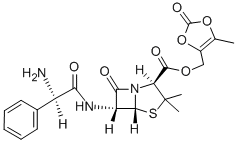(2S,5R,6R)-6-[(R)-2-Amino-2-phenylacetamido]-3,3-dimethyl-7-oxo-4-thia-1-azabicyclo[3.2.0]heptane-2-carboxylicacid , 97%+(Lossondrying≤15%) , 69-53-4
Synonym(s):
D- (−)-α-Aminobenzylpenicillin;Ampicillin;Ampicillin trihydrate
CAS NO.:69-53-4
Empirical Formula: C16H19N3O4S
Molecular Weight: 349.4
MDL number: MFCD00072036
EINECS: 200-709-7
| Pack Size | Price | Stock | Quantity |
| 5g | RMB28.00 | In Stock |
|
| 25g | RMB88.00 | In Stock |
|
| 100g | RMB223.20 | In Stock |
|
| 500g | RMB780.00 | In Stock |
|
| others | Enquire |
PRODUCT Properties
| Melting point: | 198-200 °C (dec.)(lit.) |
| alpha | D23 +287.9° (c = 1 in water) |
| Boiling point: | 201.8°C (rough estimate) |
| Density | 1.2794 (rough estimate) |
| refractive index | 1.6320 (estimate) |
| storage temp. | 2-8°C |
| solubility | NH4OH 1 M: 50 mg/mL, clear, colorless |
| form | solid |
| color | White to Pale Yellow |
| pka | 2.5 (COOH)(at 25℃) |
| biological source | microbial |
| optical activity | +287.923 (c 1.0, H2O) |
| Water Solubility | 13.9g/L(25 ºC) |
| Merck | 13,591 |
| JECFA Number | 85 |
| BRN | 1090925 |
| Stability: | Stable, but may be moisture sensitive. Incopmpatible with strong oxidizing agents. |
| InChIKey | AVKUERGKIZMTKX-NJBDSQKTSA-N |
| CAS DataBase Reference | 69-53-4(CAS DataBase Reference) |
| IARC | 3 (Vol. 50) 1990 |
| EPA Substance Registry System | Ampicillin (69-53-4) |
Description and Uses
Ampicillin is an antibacterial antibiotic from the α-aminobenzyl penicillin group, which differs from penicillin by the presence of an amino group that facilitates penetration through the outer membrane of some gram-negative bacteria.
Ampicillin is Semi-synthetic derivative of penicillin that functions as an orally active broad-spectrum antibiotic. Ampicillin acts by interfering directly with the biosynthesis of peptidoglycan, which constitutes the major component of the bacterial cell wall, leading to structural instability and death of bacteria.
Ampicillin is a β-lactam antibiotic within the penicillin family. As a member of this family, Ampicillin is susceptible to β-lactamase, which hydrolyzes the β-lactam ring. This broad spectrum antibiotic is effective against gram-positive, gram-negative bacteria and anaerobic bacteria. Ampicillin is widely used in cell culture as a selective agent. As an antibiotic, Ampicillin binds to penicillin binding proteins (PBPs) on a susceptible organism and Inhibits bacterial cell-wall synthesis by inactivating transpeptidases on the inner surface of the bacterial cell membrane. After binding to the PBPs, Ampicilin acts as a structural analogue of acyl-D-alanyl-D-alanine, acylates the transpeptidase enzyme and thereby prevents the cross-linking of the peptidoglycan of the cell wall necessary for the growth of the bacterium.
Ampicillin sodium can be used as a selective agent in several types of isolation media. Ampicillin sodium is routinely used to select for cells containing the pcDNA3.1 and pEAK10 resistance plasmids in cell line A904L at an effective concentration of 50 μg/ml.
β-lactam antibiotics
Safety
| Symbol(GHS) |  GHS08 |
| Signal word | Danger |
| Hazard statements | H317-H334 |
| Precautionary statements | P261-P272-P280-P284-P302+P352-P333+P313 |
| Hazard Codes | Xn,T |
| Risk Statements | 36/37/38-42/43-61 |
| Safety Statements | 22-26-36/37-45-53 |
| WGK Germany | 2 |
| RTECS | XH8425000 |
| F | 10-23 |
| Autoignition Temperature | 301°C |
| HS Code | 29212900 |
| Hazardous Substances Data | 69-53-4(Hazardous Substances Data) |
| Toxicity | LD50 oral in mouse: > 5gm/kg |

![(2S,5R,6R)-6-[(R)-2-Amino-2-phenylacetamido]-3,3-dimethyl-7-oxo-4-thia-1-azabicyclo[3.2.0]heptane-2-carboxylicacid](https://img.chemicalbook.com/CAS/GIF/69-53-4.gif)



